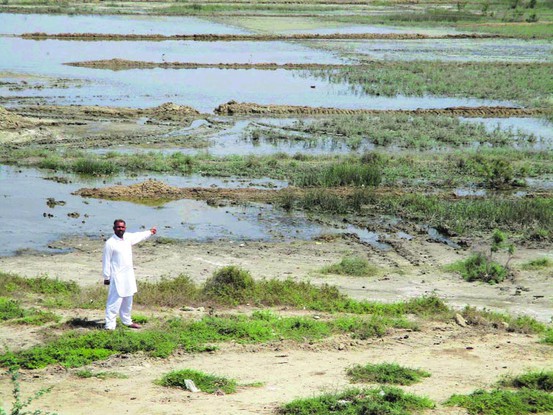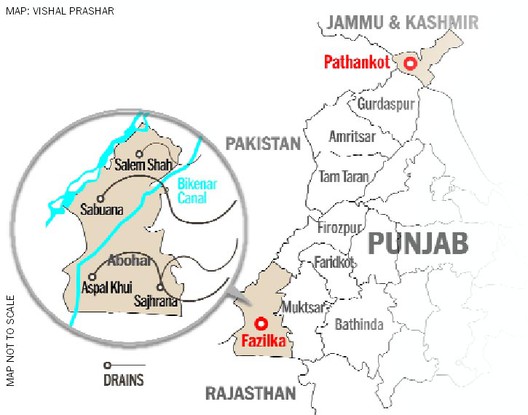Living near the border is like being perched on a live wire. The entire border belt starting from Fazilka up to Gurdaspur is an example of how things have become increasingly difficult for villagers over the years. There are no jobs, no worthwhile healthcare and crops in large tracts have been damaged by water-logging. Coupled with this is the tense security situation post Pathankot and Dinanagar terror attacks. Sarbjit Dhaliwal & Prashant Saxena travel along the route

A farmer points to a pool of drained out water in a vast stretch in Fazilka. Tribune Photo
There are signs of dystrophic malfunction in government machinery as you move beyond vast stretches of agricultural land along the Indo-Pak border from Abohar-Fazilka up to Pathankot. As the wheat crop takes a golden hue, the barbed fencing demarcating the two sides becomes invisible. You don’t even remember the names of villages; their very existence tends to be strangely surrealistic, a kind of reassertion of the ennui of the last over 67 years of partitioned history. One village here, another across the fence, tons of wheat here and tons there, roars of ‘Bharat mata ki jai’ inches within and ‘jive jive Pakistan’ a few yards away. For those looking for a radical dissimilarity in anything of substance, here’s some laconic levity in the tedium: Both sides live off water, land and air! And since this side is clearly visible, there is a perception of a deliberate attempt to keep the people off their main occupation: vast swathes of farmland lie waterlogged in the Fazilka belt, because of the natural gradient that sends even sewage water being drained out of Muktsar, the home district of Chief Minister Parkash Singh Badal, to these areas. There has been no crop for the last about two years as frothy, murky water has turned the soil into saline crust.

Official communications are slow and verbose, as officials blame Pakistan for building a bandh on their side restricting the natural flow. Indebtedness among farmers is thus rampant, and coupled with the lack of job avenues, the voices of resentment are getting louder. Trading activity across Sadiqe and Husseniwala, locked after wars with Pakistan, is something everyone wants resumed, but no one knows how. In the gamut of living, there are undiagnosed diseases among children at Teja Rohela, where some kind of muscular dystrophy or bone deformity has affected many children: they can’t walk, they crawl. Though various government and NGO surveys blame bad water and soil, none has reached a definite conclusion. There are no hospitals, only Job’s comforters. As The Tribune team travels along Fazilka-Ferozepur-Amritsar-Pathankot border route, there is much more, something well-wrapped in government files, and something such plain sight that no one really cares to feel.
Driven to debt

In village like Shajrana, well-off farmers are now feeling helpless. “Farmers with up to 80-acre land are forced to buy wheat because no crop grows in their fields due to water logging,” says Om Singh, sarpanch of the village. In and around the village, about 700 acres have been rendered infertile. “Many who once owned tractors work as labourers,” says Om Singh. “Most of the villagers are under debt.” There are pools of accumulated water in fields at Shajrana village. There is vast web of drains in the Abohar-Fazilka-Jalandhar belt. These include Aspal, Khui Kheria, Sajhrana, Bam, Salem Shah and Fazilka drains. Many of them emerge from the Muktsar region. The perception among people, especially, the ones living in the village near border in Fazilka district, is that since CM Badal wanted to get rid of water-logging in his home town Muktsar, several new drains were dug up in the area. Starting from the Lambi constituency and other parts of Muktsar these drain out into the Fazilka belt.”The Abulkhurana drain is a big nuisance. It carries filthy sewer water of Abohar town,” says Sohan Lal, a farmer and member of Panchayat Samiti. He says farmers plan to move the high court.But officials of the drainage department reject such accusations. The natural flow of water is towards Fazilka. So, water is bound to flow to that side before falling into the Sutlej. “Over the years, the state government has spent about Rs 3,000 crore in the entire Fazilka-Muktsar region solve water-logging,” says an official of the drainage department. Secretary Irrigation KS Pannu says Rs 90 crore were spent on anti-water-logging measures in Fazilka district in 2014-15 and Rs 120 crore were spent during the last fiscal year. Government officials in Fazilka blame Pakistan. Some of the drains end up in the main creek of the Sutlej that crisscrosses the international Border in Ferozepur-Fazilka belt. Farmers accuse Pakistan of blocking the flow of drains in its territory by building a bandh. Under the Indus Water Treaty-1960, Pakistan is supposed to de-silt and maintain the drains such as the ones at Salimshah, Fazilka, Hudiara and Kasur Nala which flow from the Indian side to its territory. They say the spillover from the drains often floods their crops. “We own 50 acres near the border. We also have a small tract of land across the fence on the border. We grow paddy and wheat. Flooding caused by Pakistan has made us unable to harvest last four crops. We did not get any compensation,” says Milkh Raj of Beriwala village.Additional Deputy Commissioner Development Charandev Singh Mann says about Rs 152 crore was given as compensation to farmers whose cotton crop was damaged by white fly besides about Rs 18 crore to the landless labourers affected by crop failure.Secretary Irrigation KS Pannu says the Punjab Government has written to Commissioner (Indus), Ministry of Water Resources, to take up de-silting and de-weeding of the Fazilka and other drains with Pakistan in their territory. “We have sent additional information sought by the Commissioner. De-weeding is also required inside the Indian territory.”There are hundreds of farmers who own land across the fence in about 212 villages located along the border in the Punjab region. They have been demanding relaxation in restrictions on movement. Recently when a parliamentary committee attached to the Home Affairs visited the border belt, Akali MP member Prem Singh Chandumajra suggested the government exchanged some land across the fence, wherever possible, with Pakistan. This can relieve the pressure on farmers.
Ray of hope
Hussainiwala and Sadiqe border posts were transit points until the Indo-Pak war in 1971. Trucks loaded with grapes and dry fruits arrived from Afghanistan and unloaded at the Hussaniwala post. Before Partition, there was a direct rail link between Delhi-Ferozepur-Lahore via Kasur. This line was intact till 1971. Now, all trade is done through the Attari-Wagah border post. With the opening of Hussainiwala and Sadiqe, the entire scenario in the border belt will change. It would create jobs, make industrialists think about setting up units near the border to avoid transportation cost and engineer the process of development, especially the manufacturing sector. Whenever, any senior Minister visits the memorial of Shaheed Bhagat Singh and other martyrs, people of the area demand only one thing: reopen the Hussaniwala and Sadiqe posts.
Teja Rohela’s curse
As she tries to tell the name of her five-year-old bedridden grandson, her voice starts sinking. “He was about one when he started facing difficulty in standing straight and moving about. Since then, we have spent thousands of rupees on his treatment, but there is no relief,” says Paro as she watches Swaran.”He remains confined to bed mostly. He cannot sit without support, cannot eat anything himself and even cannot remove flies from his face,” she says. There is 10-year-old Jashandeep. He crawls. His family too, has no hope. There about 14 other boys and girls in the Teja Rohela village, at a short distance from border near Fazilka, suffering from some kind of degenerative disorders like dystrophy. “These families are poor and under heavy debts,” says Raj Singh, who is holds a professional degree to teach special children.Health experts have not been able to pinpoint the exact reason. “No one has come forward to help us. We feel left out. For us, government and doctors don’t exist,” says Varinder, mother of a sick boy.state Health Minister Surjit Kumar Jayani and AAP’s convener Arvind Kejriwal have visited the village and met the families. Experts from diverse fields such as health and environment have also visited the place. But nothing has happened and villagers continue to depend on costly private health institutions.
Shadow of terror
Post Pathankot and Dinanagar terror attacks there is no visible panic among people. Yet they have bitter memories of 1965 and 1971 wars. Pardeep Kumar, who lives in a village near the border in Fazilka, says his house was damaged in both the wars. Even during the Kargil war, people of his village were asked to vacate the village because the Army had moved in close to the border. Villagers want senior security officials to stay at least a week in these areas to have the first-hand experience of the difficulties. Near the Dinanagar police station as well as around Pathankot airbase, heavy civilian population makes the two places vulnerable to attacks. Deputy Commissioner of Pathankot Amit Kumar says he has directed officials to remove unauthorized establishments from the periphery of the defence installations. The civil administration cannot interfere in the land owned by defence forces. The DC said there would be a meeting between civil and defence officials next month on ways to remove encroachment.(With inputs from Praful Nagpal, Anirudh Gupta)Border basics553 km Length of Indo-Pak border in Punjab
461 KmFenced and withfloodlights
River stretches are not fenced
Rampant unemployment
- The only industry in the vast stretch of the Fazilka-Jalalabad-Ferozepur is rice mills.
- The number of workers (per lakh population) in factories in Fazilka district is 514, Pathankot 376 and 868 in Gurdaspur. It is 155 in Tarn Taran.
- Amritsar is the only district where the number of such workers is 1,336. Reason: Amritsar is located at a considerable distance from the border.
- The number of registered factories in Pathankot is 140 and Fazilka 208, Tarn Taran 60 andFerozepur 540.
- Of the total 6,62698 workers employed in registered factories, the number is just 2,616 in Pathankot, 5,560 in Fazilka, and 1,843 in Tarn Taran.
